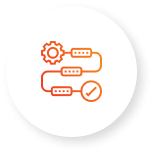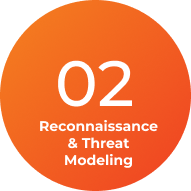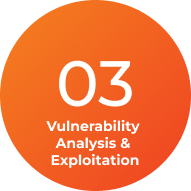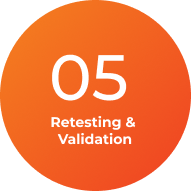SECURE YOUR MAINFRAME
MAINFRAME PENETRATION TESTING
Security vulnerabilities can lead to external or internal breaches of the existing security controls in place. Once breached, there is a high risk of compromising the confidentiality, integrity, and availability of the mission-critical mainframe systems or the data residing therein. Mainframe Penetration Testing services evaluate the security of your mainframe systems by identifying and addressing vulnerabilities that could be exploited by hackers. Safeguard your organization’s valuable data, maintain compliance with industry regulations, and strengthen your overall security posture by proactively addressing mainframe-specific risks.
Tell us
about your scope
What You'll Get

Key findings, risks, impacts, and critical recommendations.

Overview of methodologies, standards, tactics, and techniques used.

Detailed vulnerability analysis, reproduction steps, PoC, evidence.

Strategic and tactical walkthrough on how to fix vulnerabilities.

Comprehensive advice on cybersecurity enhancement strategies.

Offered once vulnerabilities are fixed.
PROTECT AGAINST THE LATEST THREATS
What is Mainframe Penetration Testing?
Mainframe penetration testing is an assessment that identifies vulnerabilities within mainframe systems, using the same techniques as hackers to breach your infrastructure. According to most mainframe manufacturers’ terms and conditions of warranty, including IBM, it is each user’s responsibility to detect and mitigate any vulnerabilities, whether at the software or hardware level. In addition, industry standards require that penetration testing needs to be performed regularly.
Secragon’s mainframe testing services offer valuable insight into your LPAR security, providing actionable guidance on how to improve your in-scope mainframes and systems security and help meet compliance requirements. We specialize in penetration tests that are 90% manual and 10% automated, designed to replicate real-world attacks. We use commercial, open source, and proprietary software, along with a mix of public and in-house developed exploits and in-depth analysis to discover vulnerabilities not yet published and often not yet discovered. We evaluate your infrastructure from the perspective of an anonymous (non-credentialed) or an authenticated (presumed breach) perspective.
We don’t just point out security holes; we help you solve them.

Presents an independent perspective of your current security posture to help IT teams demonstrate risk to executives and non-technical stakeholders effectively.
Ensure that security practices are consistent across different systems and that legacy vulnerabilities are not overlooked.
Mainframes often process and store sensitive data. Penetration testing verifies the effectiveness of security measures in protecting this data against unauthorized access or breaches.
Many industries are governed by regulatory standards that mandate regular security assessments, including penetration testing, to ensure the protection of sensitive information.
Use insights from the pentest to allocate resources strategically, focusing on your vulnerable areas.
Mainframe infrastructure is a hunting ground for ransomware attacks, which can paralyze business operations and compromise critical data.
Why Conduct a Mainframe Penetration Test?
Conducting a Mainframe Penetration Test is crucial for maintaining robust security and regulatory compliance. It provides deep insights into potential vulnerabilities and ensures that protective measures are both effective and up to date. Here is what your organization will gain after conducting a project with our team:
PROTECT AGAINST THE LATEST THREATS
When Should You Perform a Mainframe Penetration Test?
Mainframe Penetration Testing should be performed as frequently as required by the organizational security policy, with a general recommendation to conduct testing at least once per year. In addition to the regular schedule, penetration testing is particularly advisable in the following circumstances:
When new systems or applications are added to the network.
Upon the addition of new, sensitive features or components.
If the organization relocates to a new facility.
After a security incident or breach.
Following significant upgrades or configuration changes.
As a requirement or part of a regulatory or compliance audit.
We Provide Expert Solutions And Definite Results

Transparent
Pricing
Clear, upfront, with no
hidden costs.

Dedicated Project
Manager
Your security is our
commitment.

Retesting After
Fixes
Ensuring threats are
truly eliminated.

Affordable
Expertise
Premium protection,
reasonable rates.

Customized
Approach
Solutions fitted to your
specific needs.

Proactive
Protection
Effectively securing your
digital assets.
What Will be Assessed During a Mainframe Penetration Test?
Our mainframe assessment is typically split into three phases:
Non-disruptive Data
Collection
Gathering system information such as IPL parameters, dataset authorizations, hardware configurations, and security settings using standard user credentials.
Penetration
Testing
Attempting privilege elevation and checking system protections using client-supplied IDs. This includes library and password checks, public dataset and resource access, command authority, and system exit verifications.
Software
Scanning
Using specialized scanning software to detect system integrity issues and vulnerabilities in interfaces and authorized calls. A detailed report is produced to facilitate targeted remediation with IBM, third-party vendors (ISVs), and internal software teams.
Our Penetration Testing Process
If your organization has not gone through a penetration test before, you may not know what to expect. Even if you have, maybe you are wondering what Secragon’s stages of penetration testing are. Here is a high-level break down of each step of our proven process:

Activities: Engage stakeholders, define targets, plan logistics for efficient, transparent execution.
Outcomes: Scope Validation, Proposal, Contract.

Activities: Environment preparation, OSINT collection, attack scenario planning.
Outcomes: Strategy Development, Threat Insight.

Activities: Vulnerability identification, active exploitation, privilege escalation, execution of realistic attack scenarios, data and information collection, persistence maintenance, and documentation of steps.
Outcomes: Comprehensive Report, including Executive Summary, Technical Details, Impact Analysis, Recommendations.

Activities: Supporting vulnerability remediation with actionable steps and advice, answering follow-up queries.
Outcomes: Remediation Plan, Security Enhancement.

Activities: Validate the effectiveness of remediation efforts through complementary retesting.
Outcomes: Re-test Results, Attestation.
Frequently Asked Questions
Couldn’t find the information you were looking for?

SECRAGON, YOUR CYBERSECURITY PROVIDER
We, at Secragon, are a team of certified ethical hackers, visionary security engineers, seasoned penetration testers, and committed project managers… but first of all – professionals, who LIVE and BREATHE Offensive Security. Along the list of qualifications, titles, and credentials, we bring a real “think outside of the box” mindset to every project and we constantly strive to learn, explore, and push forward to master complex concepts and deliver top-notch services and results.


